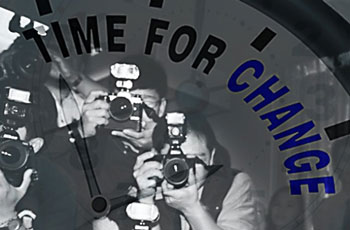By YVAN COHEN, LIGHTROCKET
Realizing the professional landscape has forever changed, many photojournalists are seeking new and creative ways to continue to earn a living doing what they love. Where once editors would have assigned a photographer, today they are often able to find the image they need with a few clicks of a mouse. Meanwhile, the vast supply of imagery made possible by the Internet and cheap digital technology has pushed license fees down, making it harder for professional photographers to earn a decent income from their stock. Here is how some photographers are reinventing themselves.
Indeed photography has become such a universally accessible from of creation and communication that many professionals have found themselves swamped by an army of camera toting bystanders and enthusiastic, but often talented, amateurs.

Despite the pessimism expressed by many professionals, there remains legions of determined souls who see opportunities in change. They are evidence that true passion doesn’t wither in the face of new technologies and shifting market realities — it adapts.
The Photojournalist as an Artist…
Many photojournalists have responded to the advancing hordes of amateurs by by recasting themselves as artists. It’s a subtle repositioning that, when successful, can give renewed gravitas and credibility to a photographer’s work.
By labeling one’s pictures not as documents but as art, there is an attempt to hoist oneself above the masses and into a more rarefied category of creators; valued more for their uniqueness of vision than their technical skills in handling a camera (digital technology has effectively removed the technical challenges of creating a well exposed and focused image).
Become a Teacher…
The rising popular interest in photography has also created an opportunity for professional photographers to reposition themselves as teachers (and occasionally as both artists and teachers). So popular a shift has this been that it sometimes seems as though almost every other successful professional photographer I meet is holding or organizing classes and workshops.
Just 10 years ago I would have struggled to name two professional photographer friends involved in or organizing workshops or teaching photography. Now I find myself struggling to name one who isn’t in the workshop business.
The blossoming of the workshop sector is a direct byproduct of professional photographers adapting to changing realities and seeking news way to parlay their (still) unique experience and knowledge into a living income.
But as the number of workshops on offer has grown, questions are also being raised about quality. The photo workshop sector is unregulated and many self appointed teachers do so with no formal qualifications — other than their experience, talent and know-how.
Potential students would do well to read up carefully on the background of their would-be teachers and even if they do there is very little guarantee that a dazzling portfolio will translate into an enriching course. Word of mouth and online commentary are perhaps the best ways to evaluate the likely quality of a teacher and his/her course.
Go Forth and Diversify…
Diversification is another typical response to changes in the industry. As the traditional role of the professional photojournalist has been eroded by crowd sourced content, many photographers are diversifying their skills, learning how to work with multimedia — creating Web presentations and working with video and editing software.
The technology required to shoot video has become more accessible not only in terms of cost but also as the equipment used to record still and moving imagery have converged. Most digital cameras today now shoot HD video footage, creating opportunities for photographers to move seamlessly between these two disciplines.
Though video technology may have become more accessible, the technical and skill barriers to producing a video report of broadcast quality are still high enough to deter many amateurs.
Many professional photographers have spotted this opening and are retooling themselves to shoot and edit video. Most already have the natural visual sensitivities needed to create video, so all that remains is to relabel themselves as “visual artists” capable of producing work using stills and video or a combination of the two in a multimedia format.
The breathless pace of technological innovation can create an impression that we are forever racing to learn the latest software or how to use an innovative piece of equipment. However much technology may have transformed the environment in which photographers operate, however, the value of great creative work driven by unique ideas can never be eclipsed by gadgetry and gear.
Technology may have changed the context in which we work, forcing us to reconfigure the ways in which we generate an income to live. But for those with ideas, passion and talent, whatever the latest format and however technology may change, there will always be a market for their work.


